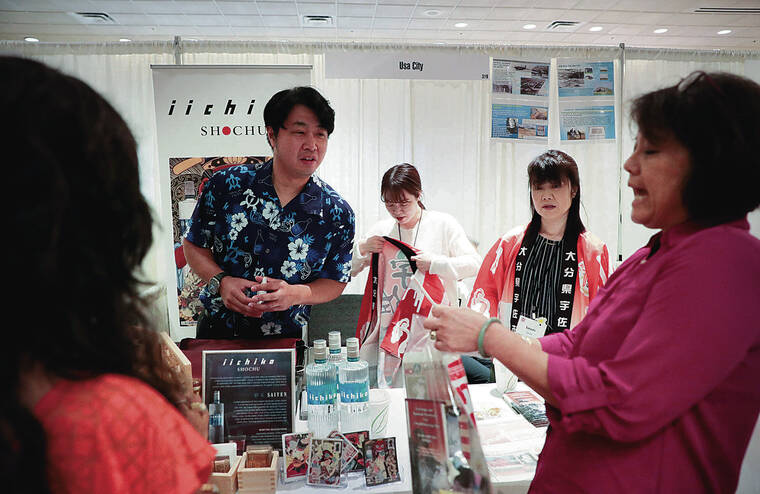Tourism in Hawaii and Japan has not recovered to the level that both destinations saw before the COVID- 19 pandemic; however, as both destinations pursue initiatives to boost arrivals, they must also take steps to avoid overtourism.
Helping each other find that balance was a key discussion Friday at the inaugural Hawai‘i-Japan Sister State and Sister City Summit. The two-day event, which started Thursday, brought together roughly 400 senior government officials and business and civic leaders split about evenly between Japan and Hawaii.
Themed “The Ties That Bind,” the summit sought to restore relationships between Hawaii and Japan that had been put on hold during the pandemic as well as forge new partnerships to invigorate the economy, and work on shared concerns such as promoting sustainability across all industries, especially tourism.
Leaders at the summit met privately to discuss tourism. It also was the main topic of remarks made by Gov. Tsugumasa Muraoka of Yamaguchi prefecture, and of a panel called “Sustainable Tourism: Pursuing Suitable Balance.”
Eric Takahata, managing director of Hawaii Tourism Japan, told the Honolulu Star-Advertiser that the summit comes as Hawaii arrivals from Japan are only 30% recovered from 2019 levels and are not expected to reach a 40%-to-50% recovery level until the end September.
“We are not expecting numbers approaching 2019 numbers until the end of 2024 or beyond,” Takahata said.
In 2019, Japan was Hawaii’s top international market, with more than 1.5 million visitors who spent more than $2.2 billion, according to the state Department of Business and Economic Development.
Japan has seen an increased number of international travelers since the government relaxed border measures for entry to Japan in October, according to Japan National Tourism Organization. However, in May, the most recent month of available data, estimated international arrivals to Japan hit only 1,898,900. While that was up 1,191.4% compared with the previous year, it was down 31.5% compared with May 2019.
State Business, Economic Development and Tourism Director James Kunane Tokioka told the Star-Advertiser that officials from sister states and cities in Japan and Hawaii met during the summit to discuss how to leverage relationships to help improve these tourism numbers as well as business, and other shared interests.
Tokioka said, “The state of Hawaii appreciated the delegations that came from Japan to Hawaii, and their residents should know that each and every one of their leaders that attended the summit worked many hours to strengthen our ties, promote educational and economic opportunities, cultural exchanges with hula and culinary arts and most of all tourism.”
He said leaders talked about creating mutual opportunities for more educational, business, cultural and sports exchanges as well as wellness programs, and egaming competitions, which are growing in popularity.
Hawaii leaders also are exploring how to support package deals that make Hawaii more affordable for travelers from Japan, he said.
Tokioka said officials from Japan have said demand for Hawaii is high and that visitors from Japan will return when the exchange rate and other economic considerations are more favorable.
Access is another impediment, said Kanta Hibino, chief of international exchange for the Hokkaido government, who was promoting travel to the prefecture at the summit marketplace. Hibino said direct flights between Chitose and Honolulu were suspended during the pandemic, and their restoration is important to tourism recovery between the destinations.
“We definitely want to see more people from Hawaii coming and more of our people coming to Hawaii,” he said.
Tokioka said Hawaii leaders also are eager for tourism improvements, and have discussed reaching out to Hawaii’s “kenjin kai,” local ancestral groups, to help encourage Hawaii residents to travel to Japan.
Dennis Ling, administrator of DBEDT’s business development and support division, said, “Tourism is always termed soft diplomacy, also culture and education. By far, Japan is our strongest bilateral relationship; a lot of these activities may lead to economic benefit, but the goodwill also is important.”
Tokioka said Gov. Josh Green is likely to continue these tourism discussions, as well as education and energy initiatives, when he visits Japan in November.
While the mutual recovery of tourism is a shared goal for Japan and Hawaii, sustainable tourism is a global trend these days, and neither destination has plans to mass- market at the expense of destination management.
Yamaguchi’s Muraoka talked about promoting the creation of sustainable tourism regions that cater to new demands by taking advantage of regional strengths from nature to history and culture to food.
Hibino said Hokkaido is promoting adventure travel, which helps manage tourism by spreading visitors to lesser-known places in the prefecture. He said Hokkaido is hosting an Adventure Travel World Summit in September.
Hawaii Tourism Authority Chief Administrative Officer Daniel Naho‘opi‘i said HTA has turned to communities across the state to develop destination management action plans to manage tourism.
“We are no longer a tourism destination, but a destination where you can be welcomed as a visitor but still remember that this is an island home for all of us and you are coming into someone’s house,” Naho‘opi‘i said.




